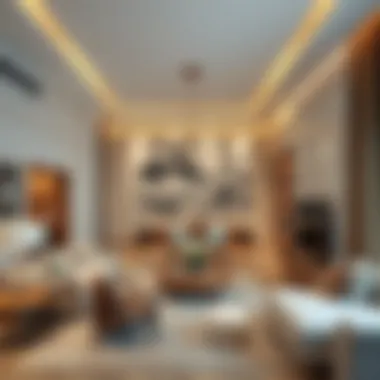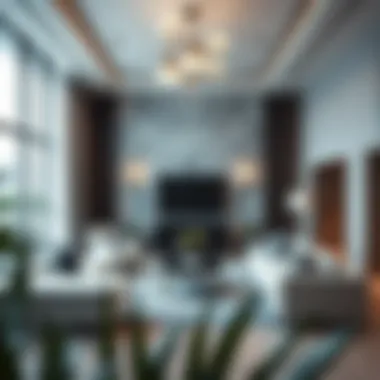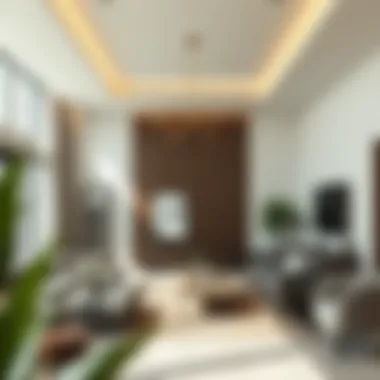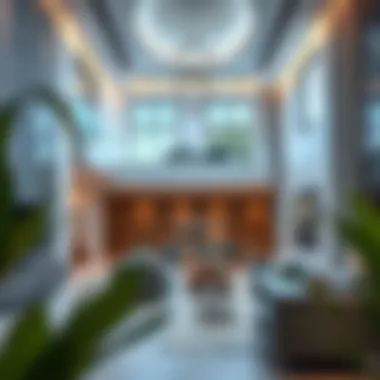Interior Design Companies Transforming UAE Spaces


Intro
Navigating the realm of interior design in the United Arab Emirates opens up a fascinating tapestry of creativity, culture, and commerce. With its unique blend of traditional influences and contemporary innovations, the UAE offers a rich landscape for interior design companies to flourish. These firms are not merely service providers; they are architects of ambiance, shaping spaces that speak volumes about lifestyle and functionality.
As the UAE continues to evolve as a hub for global business and tourism, the demand for inventive and striking interior designs is on the rise. This progression has led to a vibrant marketplace where innovation meets tradition, addressing the nuanced needs of clients ranging from homeowners to commercial enterprises.
Understanding this internal landscape is vital for potential investors and stakeholders. It helps establish a connection with local trends and practices that ensure effective and culturally relevant design solutions. From the towering skyscrapers in Dubai to the serene villas in Abu Dhabi, the work of these design firms resonates deeply in both personal and communal environments.
This article aims to unravel the intricate layers of the interior design scene in the UAE. We will dissect current market trends, investment opportunities, and the cultural elements that shape design choices. Furthermore, we will explore how design companies respond to the ever-changing expectations of clients, creating spaces that are not only aesthetically pleasing but also functional and meaningful. By delving into this vibrant sector, we can better appreciate how interior design is not just about aesthetics but also about enhancing the quality of life for individuals and communities alike.
Start seeing the connections between design, culture, and lifestyle—where each piece is more than just furniture or decor, it’s a reflection of identity and aspirations.
The Evolution of Interior Design in the UAE
The importance of understanding the evolution of interior design in the UAE cannot be overstated. This journey reflects not only the architectural trends and preferences but also the cultural, social, and economic transformations that have marked the region over the decades. The rise of opulent skyscrapers in Dubai or the traditionally inspired homes of Abu Dhabi serve as a testament to how interior design practices have adapted and evolved, catering to both local customs and international tastes. Highlighting the evolution of design practices helps clients and stakeholders understand the framework within which modern designers operate, grounded in rich history yet forward-looking in their innovations.
Historical Context of Interior Design in the Region
The historical context of interior design in the UAE can be traced back to its roots in Bedouin lifestyles. Traditionally, homes were simplistic, focusing on functionality and modesty over aesthetics. Tents made of goat hair or palm fronds were common, providing shelter while allowing for ventilation in the hot climate. As urbanization began to take root in the mid-20th century, particularly when oil was discovered, the transformation of living spaces gradually took place. Local materials such as mud and palm wood were replaced or complemented by brick and concrete, mirroring external influences, which set the stage for modern design principles to infiltrate the region.
Transformation Influenced by Globalization
Globalization drastically reshaped the interior design scene in the UAE. The influx of expatriates and foreign investment introduced diverse design preferences and practices to the market. With that, the concept of luxury started to swell, leading to a growing demand for high-end designs that blended international styles with local aesthetics. For instance, lavish hotels like the Burj Al Arab depicted intricate Islamic geometric patterns fused with contemporary design elements. This melting pot of styles and influences has enriched the UAE’s design landscape, making it a hub of innovation and creativity that appeals to both residents and tourists alike.
The Rise of Contemporary Design Practices
In recent years, contemporary design practices have taken center stage in the UAE. This rise can largely be attributed to a younger generation who prefers modern over traditional designs. Features such as open floor plans, minimalistic aesthetics, and the use of sustainable materials are increasingly popular, reflecting a shift towards practical elegance. Designers today prioritize function alongside form, creating spaces that meet the diverse needs of modern life. Designers also tap into smart technologies, ensuring residents enjoy the comforts of high-tech living. This emphasis on innovation signals that the UAE will continue to be an exciting frontier for interior design, blending heritage with the latest advancements.
"Interior design in the UAE mirrors the country's evolution, revealing not only its ornate beauty but also its ambitious spirit and cultural narrative."
In summarizing the evolution of interior design in the UAE, it is clear this journey reflects broader societal changes that signify growth and adaptability. As design firms navigate through this ever-changing landscape, understanding these historical and current contexts will empower them to forge more relevant connections with their clients and the communities they serve.
Key Services Offered by Interior Design Companies
When approaching interior design in the UAE, it's essential to know the breadth of services available. This isn’t just about aesthetics; it’s about creating spaces that align with functionality, culture, and personal taste. Tailored solutions are essential in a market that varies from opulent villas to modern office spaces. Understanding these services helps clients make informed decisions that resonate with their vision while addressing practical needs.
Residential Design Solutions
Residential design solutions involve crafting personalized environments that embody the homeowner’s identity and lifestyle. This process encompasses everything from selecting a color palette to strategizing furnishings. It requires keen attention to detail and a grasp of how families interact within their spaces. One common approach is to integrate traditional Emirati elements, like geometric patterns or intricate woodwork, with contemporary aesthetics to create a unique blend of old and new. This not only enhances the visual appeal but also fosters a connection to the local heritage.
The right residential design does more than beautify; it enriches lives by making daily activities enjoyable and engaging.
Moreover, it’s crucial for designers to conduct proper assessments—taking into account the functionality of each room and the individual needs of the occupants. Additionally, sustainable practices are becoming increasingly popular, reflecting a commitment to environmental considerations, which can also save homeowners money in the long run with energy-efficient solutions.
Commercial Space Planning
Commercial space planning is fundamentally about optimizing the use of space to enhance productivity and user experience. Unlike residential projects, commercial spaces serve varied functions, and you might find that what works in one context does not in another. An office should foster collaboration, while a retail environment must attract foot traffic. Designers need to grasp the business model involved to offer relevant advice and create spaces that resonate with customers and employees alike.
For instance, in a bustling city like Dubai, where businesses thrive on energy and vibrancy, integrating platforms for social interaction can enhance team synergy. This includes zones that promote collaboration, quiet areas for deep work, and even leisure spaces. It’s a balance between creating a working atmosphere and allowing for productivity, which invariably leads to employee satisfaction.
Consultation and Project Management
The path from concept to execution can be fraught with challenges, especially for those unfamiliar with the intricate world of design. Hence, consultation and project management services are invaluable. They keep projects on track, ensuring that timelines are adhered to and budgets remain intact. A solid consultation phase involves in-depth discussions with clients to understand their needs, desires, and potential challenges.
Once the design phase begins, project managers oversee all aspects—from ensuring high-quality craftsmanship to coordinating with contractors and suppliers. This service helps demystify the process for clients while providing a sense of security that their investment is being handled diligently. Knowing you have a professional steering the ship can give clients peace of mind during often-stressful renovations or builds.
3D Visualization and Rendering Services


In today’s digital age, 3D visualization and rendering are a game-changer. These tools allow clients to see their future spaces before a single piece of furniture is moved in. Renderings can communicate colors, materials, and layouts in a way that traditional blueprints simply cannot achieve.
Clients can tour their spaces virtually, offering them a clearer picture and the option to make adjustments before construction begins. This clarity can save both time and money as it can prevent costly miscommunications and changes during the build process. Furthermore, it’s an excellent opportunity for firms to showcase their creativity and technical skills.
This blend of technology isn’t just about visual appeal; it also aligns perfectly with the UAE's forward-thinking reputation. Adopting cutting-edge technologies not only sets companies apart in a competitive market but also caters to a clientele that values innovation.
Influence of Culture on Interior Design
Understanding the influence of culture on interior design is essential, especially in a melting pot like the UAE. The region’s rich history and diverse population contribute to a distinctive design narrative that combines tradition and modernity, creating spaces that are both functional and aesthetically pleasing. This intricate relationship invites interior design companies to embrace cultural nuances in their work, resulting in environments that resonate with local identity while appealing to global sensibilities.
Integrating Traditional Emirati Elements
When considering the integration of traditional Emirati elements into modern interior spaces, there is a wealth of inspiration to draw from. This includes the use of motifs inspired by the region's heritage, such as geometric patterns and calligraphy, which can be incorporated into wallpaper, textiles, and furniture. For example, using intricate mashrabiya screens not only provides aesthetic appeal but also acts as a functional element for privacy and ventilation.
By weaving these traditional elements into contemporary interiors, designers can create a sense of place that honors the past while embracing the future. Clients often find comfort in designs that reflect their cultural identity, fostering an emotional connection with their spaces.
Balancing Modern Desire with Cultural Respect
The task at hand for interior designers is to balance modern desires with respect for cultural heritage. In the UAE, clients may seek cutting-edge designs and luxury finishes, yet they also wish for their homes to reflect their cultural roots. Designers are challenged to create a harmonious environment where modern furnishings coexist with traditional artifacts.
This can involve thoughtful selection of materials, such as using local stone or fabrics that echo the colors of the desert landscape. It’s not simply about aesthetics; it’s about creating a narrative. For instance, a modern living room can be furnished with sleek, contemporary lines while featuring a traditional coffee table crafted from locally sourced wood. This blend offers a rich tapestry of experiences for inhabitants and visitors alike.
Color Schemes and Material Choices Reflecting Heritage
Color schemes and material choices play a pivotal role in creating a culturally resonant space. Designers often draw on the UAE’s landscape, utilizing earthy tones found in the desert sands alongside the vibrant hues of local flora. Such palettes evoke a deep sense of place, enhancing emotional well-being and connectivity with the environment.
Material choices also reflect local traditions. Utilization of techniques like stucco or ceramics, which have historical significance in the region, can ground a design in its cultural context. The aim is to reflect the UAE's heritage while ensuring that the selected materials align with modern sustainability principles. For example, combining reclaimed wood with locally produced textiles creates both a narrative and sustainable practice.
This blending of color and material not only envelops the occupants in cultural relevance but also promotes sustainability and modern aesthetics.
Architectural Trends Shaping the UAE
The architectural landscape of the United Arab Emirates is constantly evolving, reflecting the unique blend of tradition and modernity that defines this vibrant region. These architectural trends not only influence the aesthetics of buildings but also have broader implications for sustainability, technology, and urban living. Understanding these trends is crucial for investors, buyers, and other stakeholders looking to navigate the rapidly changing market.
Sustainable and Eco-Friendly Materials
As the world leans increasingly towards sustainability, the UAE is no exception. Many interior design companies are embracing sustainable and eco-friendly materials in their projects. This is a multifaceted trend that touches upon the materials used in construction as well as finishes in interiors.
Using materials such as recycled metal, bamboo, and reclaimed wood can significantly reduce environmental impact. Not only are these materials often more efficient than traditional options, but they also create unique textures and visual interest that resonate with contemporary aesthetics. By prioritizing sustainability, interior design firms are not only meeting client demands but also contributing to the UAE's goals for a greener future.
"Incorporating eco-friendly materials is not just a trend; it's a responsibility for the future of our planet."
Smart Home Integration
With technology weaving itself into the very fabric of daily life, smart home integration has emerged as a key focus area for interior design. It’s all about enhancing comfort, convenience, and the overall living experience. From automated lighting systems to smart thermostats, the internet of things (IoT) is revolutionizing how spaces are designed and utilized.
Considerations such as user-friendly interfaces and seamless connectivity are critical when incorporating smart features. Notably, the integration must not disrupt the aesthetic; rather, it should enhance it. For example, hidden speakers or discrete security cameras are designed to blend in effectively, maintaining the interior’s visual appeal while offering cutting-edge technology solutions.
Minimalism vs. Maximalism in Urban Areas
When it comes to furnishing and decor, a debate has emerged between minimalism and maximalism, particularly in urban settings. Minimalism advocates for simplicity and a clutter-free environment, focusing on function and subtle beauty. It aligns well with contemporary design principles, making it a popular choice among urban dwellers seeking a sense of peace amid the hustle and bustle.
On the other hand, maximalism embraces bold colors, patterns, and an eclectic mix of styles to create spaces that are as lively as the city they inhabit. This trend allows for personal expression and storytelling through design, appealing to those who want their space to be a reflection of their vibrant lifestyle.
Both styles have their merits, and many designers are finding ways to meld these approaches. For example, a minimalist layout paired with maximalist art pieces creates a striking visual dynamic, combining the ease of minimalism with the expressive nature of maximalism.
Choosing the Right Interior Design Firm
Choosing the right interior design firm in the UAE is a pivotal decision for anyone looking to enhance their space, whether it be residential or commercial. The region, known for its luxurious developments and diverse cultural influences, warrants a careful selection process. An ideal firm not only understands aesthetic principles but also possesses the ability to translate the client’s vision into a tangible outcome. Therefore, this section dives into various elements that can guide individuals in making informed choices.


Evaluating Portfolios and Client Testimonials
When it comes to selecting an interior design firm, scrutinizing portfolios becomes paramount. A firm’s portfolio showcases its range of styles and previous projects. This gives potential clients a tangible feel of what to expect. Moreover, don’t overlook client testimonials; they act as a mirror reflecting not just the design efficacy, but also the firm’s professional ethics and responsiveness.
- Visual Testimonials: Seek out visual proofs of past projects. These can range from completed residential homes to vibrant commercial spaces.
- Diversity of Styles: Ensure the portfolio displays a breadth of design aesthetics, from traditional to contemporary. This might also hint at the firm’s adaptability.
- Testimonials: Read through client reviews, often available on the firm’s website or third-party sites like yelp.com or even reddit.com. Genuine feedback often uncovers hidden strengths or weaknesses of the firm you wish to engage.
Understanding Design Philosophy and Approach
Each interior design firm possesses a unique design philosophy that influences how they approach projects. Understanding a firm’s design philosophy can assure alignment with your vision.
- Creative Process: Engage with the firm about their creative process—do they prioritize functionality, sustainability, or trends?
- Collaborative Spirit: A firm’s willingness to work collaboratively with clients can signify a more personalized experience, allowing your preferences to shape the design.
- Adaptability: Look for firms that can infuse local culture into their designs while remaining open to modern aesthetics. It is a fine line that separates traditional from contemporary and finding a firm that can navigate this beautifully is key.
Budgeting and Cost Considerations
A prudent client understands that budgeting is as crucial as the design itself. Engage potential firms in transparent discussions regarding costs to avoid any misunderstandings down the line.
- Initial Consultations: Many firms offer free consultations—this can be a good opportunity to gauge potential costs without a hefty commitment.
- Detailed Quotes: Ask for detailed quotations that break down expenses among materials, labor, and design fees. This will aid in spotting any hidden costs.
- Flexibility: Look for designers who can work within your budget. A true professional will suggest ways to achieve quality results without draining your wallet.
"A well-planned budget does not limit creativity; it provides a framework within which amazing designs can flourish."
The Role of Technology in Interior Design
In today's fast-paced world, the integration of technology in interior design is more than just a trend; it's a necessity. As the UAE continues to establish itself as a hub for innovation, the realm of interior design also embraces cutting-edge advancements. This intersection not only enhances the creative process but also streamlines project execution and elevates client engagement. Understanding how technology plays its role in interior design can help investors, buyers, agents, developers, and expatriates to make informed decisions.
One significant advantage of incorporating technology is that it allows for enhanced visualization during the design phase. Clients can now see their spaces come to life even before the actual work begins, enabling better communication and reducing misunderstandings. With tools such as 3D modeling and virtual reality, the abstract becomes tangible, helping to bridge the gap between concept and reality.
Use of Virtual Reality in Client Presentations
Virtual Reality (VR) is shaking up the traditional presentation style in the interior design sphere. By generating immersive experiences, VR lets clients step inside their future spaces. This technology offers a unique perspective that simple 2D sketches or 3D renderings can't provide. Clients can walk through their redesigned homes or commercial spaces, interact with different elements, and even make real-time changes.
"Virtual reality can transport clients into their designs, allowing them to experience colors, textures, and space in a way that photos cannot convey."
This level of engagement not only excites clients but also cultivates trust. When clients can visualize their investment, they become more likely to commit to the proposed designs. The transparency that VR offers fosters a sense of collaboration between designers and clients, ultimately leading to a more satisfying outcome.
Project Management Software Tools
Managing a design project in the UAE can be vastly different than doing so in more traditional markets. Given the fast-paced environment and unique regulatory challenges, a robust management tool can make a world of difference. Interior design firms are leaning heavily into project management software like Trello, Asana, or specialized design tools that help in tracking workflows, timelines, and client interactions.
These tools facilitate real-time collaboration. Designers, contractors, and clients can stay updated on the project's status, share ideas, revise schedules, and manage budgets efficiently. Importantly, this minimizes the chances of delays, which is critical for maintaining strong relationships in the competitive UAE market.
- Streamlined Communication: Everyone involved can comment or add files directly to tasks, keeping all correspondence organized and accessible.
- Budget Tracking: Helps design firms stay within financial boundaries, an essential aspect, especially for clients wary of overspending.
- Timeline Management: Setting deadlines and dependencies ensures that every project participant knows their responsibilities.
Innovations in Design Software
The landscape of interior design continues to evolve with advances in design software. Modern programs like SketchUp, AutoCAD, and Revit offer a wealth of capabilities that have transformed how designs are created and shared. These applications enhance precision and allow designers to focus on creativity without being bogged down by the minutiae of manual drafting methods.
One notable innovation is parametric design. This technique allows designers to input variables that automatically adjust elements within a design. For instance, if a designer alters the dimensions of a room, the software will instantly adjust furniture layout and lighting accordingly. Such flexibility is invaluable in fast-paced settings where changes might arise frequently.
Moreover, cloud-based platforms enable collaboration across geographies, thus facilitating international projects. Designers can easily share their vision with clients or team members regardless of location, which is particularly advantageous given the diverse demographic of the UAE.
Challenges Faced by Interior Design Companies
In today's competitive market, interior design firms in the UAE face a multitude of challenges that can shape their strategies and impact project outcomes. Understanding these hurdles is crucial not just for the designers themselves but also for clients who are seeking to create spaces that meet their expectations. Several factors come into play when discussing these challenges, including client expectations, regulatory requirements, and managing project finances.
Client Expectations vs. Realistic Deliverables
One of the most significant challenges is the gap between what clients expect and what can be realistically delivered. Clients often come with high hopes and sometimes idealized visions of their dream spaces, especially given the rapid advancements in design technologies and trends. However, the reality can be starkly different.


- Many clients may not grasp the full scope of the design process, from conceptualization to execution. They may envision elaborate designs that, while beautiful, end up being impractical due to space limitations or budget constraints.
- For instance, a client might request floor-to-ceiling glass walls to enhance natural light, unaware of the structural implications and associated costs.
Interior designers must strike a delicate balance—communicating effectively with clients to manage these expectations while still maintaining the integrity of the design. Transparency in discussions about what is feasible is key. Through iterative feedback sessions, designers can guide their clients through realistic options that align with their visions, yet adhere to both time and budget constraints.
Navigating Regulatory Requirements
In the UAE, regulatory landscapes are complex. Each emirate can have its own set of rules that govern how properties are developed and designed. This makes it essential for interior design companies to stay informed about local laws, building codes, and safety regulations.
- Architects and designers need to ensure that their designs comply with fire safety standards, accessibility guidelines, and environmental regulations. Failure to adhere can result in costly setbacks.
- Permits must often be acquired before work begins, and the processing time for these can vary widely.
Navigating this regulatory maze requires a proactive approach. Companies often need dedicated personnel whose role is to keep abreast of changing laws and policies, enabling the design teams to focus on creativity without running afoul of legalities. Collaboration with local authorities can also help streamline the approval process, ensuring that project timelines remain intact.
Managing Budget Overruns and Delays
Budget management is another area where design companies face significant obstacles. Projects can quickly spiral out of original financial plans due to unforeseen issues such as material price hikes, labor shortages, or scope changes initiated by the clients mid-project.
- Having a detailed budget is vital, but even then, it’s challenging to account for every variable.
- Implementing rigorous project management practices and maintaining a buffer for unexpected expenses can alleviate some pressure. Regular budget reviews and updates allow designers to keep financial aspects on track.
Delays can also stem from supply chain interruptions, which have been especially notable in recent years due to global events. Interior design firms must develop resilient supply chains, foster relationships with multiple suppliers, and consider alternative materials where necessary to mitigate risks.
"A good plan implemented today is better than a perfect plan implemented tomorrow."
Designers that embrace flexible strategies can not only adjust to challenges but also provide their clients with the service they expect without losing their unique design signatures. These challenges require adept problem-solving and communication, ensuring that both firms and clients can achieve their goals together.
Future Trends in Interior Design in the UAE
The interior design landscape in the UAE is on the cusp of transformative change as societal values evolve and newer generations advocate for spaces that not only embody aesthetic appeal but also foster well-being and sustainability. Understanding these future trends in interior design is pivotal for stakeholders, from potential investors to developers and expatriates seeking insights. The following trends point towards a significant shift in how spaces are envisioned and executed, steering design companies towards innovative practices that align with contemporary demands.
Embracing Biophilic Design Principles
Biophilic design has emerged as a cornerstone principle, emphasizing the deep connection between occupants and the natural environment. In the fast-paced urban setting of the UAE, incorporating natural elements into design can create a sense of peace and tranquility. This can manifest through:
- The Use of Natural Materials: Wood, stone, and clay bring a touch of nature indoors, offering a warmth that artificial materials simply can't replicate.
- Indoor Plants: Strategically placing greenery not only enhances aesthetics but also improves air quality, which is critical in urban environments.
- Natural Light: Designing spaces that maximize sunlight penetration can uplift the mood and productivity of inhabitants.
By adopting biophilic principles, interior design companies can appeal to both health-conscious consumers and environmentally aware entities, fostering a welcoming environment that promotes mental well-being.
Focus on Health and Wellbeing in Design
In recent years, there has been a noticeable surge in the focus on health and wellbeing within interior spaces. The UAE's urban lifestyle, marked by hustle and bustle, makes it essential for interiors to serve as sanctuaries. Key components include:
- Air Quality Management: Employing advanced filtration systems and using low-VOC (volatile organic compounds) materials can significantly enhance the indoor air quality.
- Ergonomic Design: Furniture that supports good posture aligns with the growing trend of wellness-focused environments, suitable for long hours of use.
- Mindful Spaces: Areas designated for relaxation or meditation can play a pivotal role in providing balance amidst the chaos of daily life.
By weaving health-conscious elements into design, companies can resonate more profoundly with clients looking for more than mere aesthetics.
Experiential Design and Its Impact
The concept of experiential design centers on crafting meaningful interactions within spaces. In the UAE, where luxury and uniqueness often overshadow practicality, creating experiences can set design companies apart. Key aspects involve:
- Multi-Sensory Experiences: Integrating sound, smell, and texture into design can evoke emotions and memories, making spaces memorable.
- Interactive Elements: Introducing technology that allows users to engage with their environment—like smart lighting that adapts to the time of day—can significantly enhance functionality.
- Cultural Relevance: Infusing local culture into design narratives leads to a sense of belonging, connecting inhabitants with their heritage.
These experiential elements are more than decorations; they transform spaces into stories, providing depth that many clients are seeking today.
In summary, the future trends in the UAE's interior design include a strong emphasis on biophilic elements, health-conscious design, and creating unique experiences that resonate with users. As interior design companies navigate these shifts, their ability to adapt and implement these trends will significantly influence their success in a competitive market.
End
The topic of conclusion holds a significant place in the discourse on interior design companies in the UAE. This section brings everything into focus, reflecting on the various aspects discussed throughout the article, and solidifying the takeaways for the reader. The importance of understanding the landscape of interior design in the UAE cannot be overstated; it is intertwined with cultural nuances, economic factors, and future trends that shape how spaces are conceived and executed.
Summation of Key Insights
To recap, several key insights can be distilled from our exploration:
- Cultural Sensitivity: Successful interior design companies in the UAE seamlessly blend cultural heritage with modern aesthetics, crafting spaces that resonate with both locals and expatriates. The inclusion of traditional Emirati elements provides a unique flavor that stands out in the competitive market.
- Diverse Service Offerings: Interior design firms provide a comprehensive array of services ranging from residential solutions to extensive commercial project planning. This diversity caters to various needs, allowing clients to customize their experiences based on individual circumstances and preferences.
- Technology's Role: The infusion of technology in design practices ushers in a new era of visualization and collaboration. Tools such as virtual reality allow clients to experience proposed ideas before implementation, ensuring satisfaction and alignment with expectations.
- Future Orientation: Embracing sustainability and health-conscious design principles is not merely a trend but a necessity in today’s evolving landscape. As clients increasingly prioritize their well-being and environmental considerations, interior design companies are adapting accordingly, providing spaces that improve quality of life.
Final Considerations for Clients in the Design Process
For potential clients contemplating engaging with interior design services, there are several factors to keep in mind:
- Research and Reviews: Take time to evaluate portfolios and client testimonials. Understanding a firm's previous work can provide insights into their capabilities and design philosophy.
- Clear Communication: Establishing a solid line of communication is critical. Discuss your vision, budget constraints, and timeline openly, ensuring that the designers align with your expectations from the get-go.
- Flexibility and Adaptability: Be prepared for adjustments. While it’s vital to have a clearly defined direction, flexibility can lead to unexpected and delightful enhancements along the design journey.
- Budget Considerations: It’s crucial to set a realistic budget at the onset. This not only helps in avoiding unexpected overruns but also paves the way for transparency in dealings with the design company.
The conclusion encapsulates the essential elements of the UAE's interior design landscape, offering valuable guidance for those looking to enhance their living or working spaces. By staying informed and engaged throughout the design process, clients can truly benefit from the rich array of services offered by the Emirati interior design companies.







